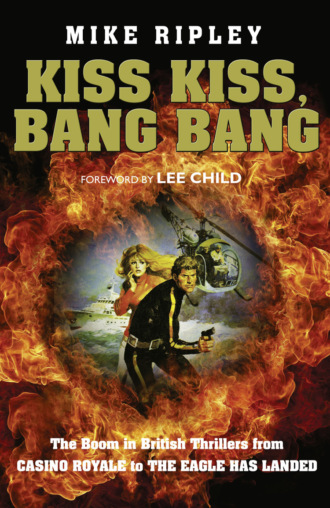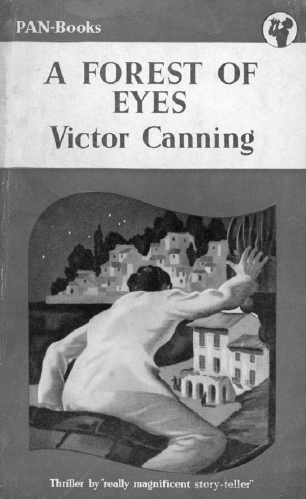
Полная версия
Kiss Kiss, Bang Bang: The Boom in British Thrillers from Casino Royale to The Eagle Has Landed
Unlike the grey and shady worlds created before the war by those masters of the more ‘realistic’ spy novel, Graham Greene and Eric Ambler (and indeed W. Somerset Maugham in his influential 1928 ‘novel of the secret service’ Ashenden – or The British Agent), Fleming had created a Technicolor dream land littered with fast cars, trips abroad, good food, fine wines, and beautiful women. It was just the sort of fantasy needed to brighten the monochrome Fifties landscape.
Confident that he had written a successful thriller, Fleming himself indulged in a bit of fantasy. He bought a gold-plated typewriter and then requested a first print run of 10,000 copies from his publisher. The publisher, Jonathan Cape, took this request from a debut author as seriously as any publisher ever takes a request from a writer and printed half that quantity. That first run sold out in under a month and Fleming was left grinding his teeth when a second print of only 2,000 copies went equally quickly.4
However shaky, to Fleming, was the start for Casino Royale (though many a contemporary crime writer would be very pleased, in fact rather smug, with that initial hardback print run), it has been estimated that within five years, once the Pan paperback edition had appeared in 1955, a million Britons had bought Casino Royale, though fewer than one in 10,000 would ever visit a casino.5 They did not have to: the fact that James Bond was quite at home in a casino or a five-star hotel, or on a transatlantic jet-liner or a beach in Jamaica, was fantasy enough for most readers in those austere times.
There was another male fantasy which James Bond provided in satisfying quantities in comparison with what had gone before: sex. Kingsley Amis put it succinctly thus: ‘No decent girl enjoys sex – only tarts. Buchan’s heroes believed this. Fleming’s didn’t.’
It may seem that James Bond provided everything readers, at least male ones, desired that they were denied in real life: sex, travel, luxury branded goods, un-rationed foods, alcohol, sadistic villains and guns to battle them with, cars, and all with an impressive salary of £1,500 a year, as well as a small private income, as revealed in Moonraker. (Bond’s boss, ‘M’, by the time we get to On Her Majesty’s Secret Service, received a staggering £5,000 a year, almost as much as a Chancellor of the Exchequer.) Which red-blooded male would not want to be James Bond (perhaps without the famous Casino Royale carpet-beater torture scene), let alone read about him?
Yet in the overall thriller market, Bond did not have it all his own way, far from it. Fleming himself took a keen interest in how his rivals in the bookshops were doing and in 1955 undertook a piece of undercover work, wining and dining an executive from a rival publisher, Collins. He was somewhat chastened to learn that the books of the leading writer of adventure thrillers, Hammond Innes, were regularly selling between 40,000 and 60,000 copies in hardback and were already proving successful as Fontana paperbacks.6 They were to be even more successful in the next decade, despite the fact that they contained no sex or sadism and relatively little violence. Innes’ heroes were anything but supermen, rather they were invariably honest, decent, and upright citizens. They certainly did not have expensive tastes in wine, food, or clothes and were more likely to be found driving a bulldozer or a snow plough than a supercharged Bentley (though Hammond Innes’ books always supplied a touch of the exotic through their settings). The reader could always rely on Innes for an exciting scene or two involving skiing or sailing, usually in extreme weather conditions, and travel to a foreign land unfamiliar to most readers. The Strange Land, published in 1954, was far from one of Innes’ best adventures but it was set in Morocco, a country which today is considered a tourist destination only a three-hour-flight away but for most readers back in 1954 must have been as mysterious as Conan Doyle’s The Lost World.
There was also competition from other thriller writers who were now seasoned veterans. Dennis Wheatley, who had briefly worked with Fleming on deception initiatives during the war, was exorcising his two favourite demons in the shape of communism in Curtain of Fear and Satanism in To the Devil – A Daughter. That other stalwart of the thriller genre, Victor Canning, who like Wheatley and Innes had first been published before 1939, was also enjoying considerable success. Three of his thrillers – The Golden Salamander, Panthers’ Moon and Venetian Bird, set in Algeria, the Swiss Alps, and Venice respectively – had been filmed between 1950 and 1952, with reliable British stars such as Trevor Howard and Richard Todd. In 1953, arguably Canning’s best spy story A Forest of Eyes was published as a Pan paperback. Set in Yugoslavia, this book was clearly influenced by Eric Ambler’s 1938 thriller Cause for Alarm set in Italy (Canning and Ambler were wartime pals), which also, coincidentally, became a Pan paperback in 1954.

A Forest of Eyes, Pan, 1953

Campbell’s Kingdom, Fontana, 1956
Paperback editions were becoming an important factor in the thriller market, both in style and volume. The Pan edition of Canning’s Venetian Bird had a ‘film tie-in’ style cover (though an illustration rather than a still photograph from the film) clearly showing Richard Todd in the lead role. The later Fontana paperback of Hammond Innes’ Campbell’s Kingdom similarly referenced the 1957 film, with an illustration of star Dirk Bogarde. On the crime fiction front, Penguin had shown what could be done in terms of volume by launching an author as a ‘millions’ author, starting in 1948. Prolific crime writers such as Agatha Christie, Dorothy L. Sayers, Margery Allingham and John Dickson Carr would have ten titles issued simultaneously, each with a print run of 100,000 green-jacketed copies, making a million paperbacks per author.
Cheap paperbacks may well have ‘democratised literature’ and even, in lieu of a shrinking Empire, spread British values across the world7 but they were not the only source of popular fiction. Between 1949 and 1959, the number of books in public libraries increased from forty-two million to seventy-one million, and an estimated 70 per cent of borrowings were thought to be fiction8 which naturally gave rise to grumbling in some quarters that ‘fiction on the rates’ was not a good use of public finances. It was hardly a subversive socialist plot as much of the library expansion came under Conservative governments, perhaps to help convince voters that they had never had it so good and as more than a quarter of the British population had a library card, it was a constituency too large to ignore.
Not all libraries were in the public sector: there were commercial subscription libraries such as the Boots Booklovers Library in branches of Boots the High Street chemist. Established in 1898, the BBL attracted one million subscribers during World War II and, by 1945, Boots were buying 1.25 million books a year, but the decline set in during the Sixties with the boom in paperbacks and the Boots operation closed in 1966. A similar fate awaited the W. H. Smith Lending Library which had opened in 1860 and had specialised in crime and romantic fiction initially for railway passengers. It issued its last borrowings in 1961, though some subscription libraries attached to large department stores did continue to service loyal customers into the Nineties.9
For those thriller addicts who could not wait for the paperback of a favourite author’s latest, usually a minimum wait of at least two years in the Fifties (often three, sometimes five), a number of book clubs started up offering cheaper hardback editions to members who usually subscribed to a set number of titles per year, one of the earliest being the Thriller Book Club. These clubs were to flourish in the Sixties, often producing their own promotional catalogues and developing stylish artwork for the jackets. They attracted the biggest-selling authors of the day and continued into the 1980s.
From 1956 onwards, starting with Live and Let Die, Fleming’s Bond novels also appeared in cheaper editions published by The Book Club (established by Foyles, the bookseller), usually a year after the first hardback editions and a year before the paperback. The Bond novels also began to be serialised in national newspapers – an increasingly important promotional tool for books, as not only did more people use libraries in the Fifties, they also read more newspapers. From Russia, with Love was the first, serialised in the Daily Express in 1957 at the time the book was published (a comic strip version was to follow in 1960) and this undoubtedly helped sales.
Fleming’s publishers (Jonathan Cape) were confident enough to have produced an initial print run of 15,000 copies of From Russia, with Love and it is difficult now, knowing how famous the title became, to understand how the book could not have been the top-selling thriller of 1957. The problem was that Bond was being out-gunned and out-actioned – if not ‘out-sexed’ – by another sort of thriller. The Guns of Navarone, a rousing, wartime adventure thriller and the second novel by a newcomer called Alistair MacLean, reputedly sold 400,000 copies in its first six months.
MacLean was just one of several new thriller writers to make their mark in the decade of James Bond’s creation – along with such as Francis Clifford, Berkely Mather, John Blackburn and Desmond Cory (who does have something of a claim to having beaten Fleming to producing the first ‘licensed to kill’ secret agent). None were, in the long run, likely to seriously compete with Fleming and Bond, but for a while, MacLean certainly did. However, once Fleming’s books started to be filmed (something Fleming had been very keen on from the start – perhaps, as it turned out, too keen), Bond’s iconic status was assured of immortality.
Fantasist though he might have been, even Ian Fleming could not have seen the future and the scale of the industry his creation would become, but he did have the wit to acknowledge the man who had shaped the more realistic modern spy thriller: Eric Ambler.
As James Bond faces execution at the hands of assassin Red Grant across a compartment on the Orient Express in one of the most famous scenes in From Russia, with Love, both men have books to hand. Grant has a copy of War and Peace which is actually a cunningly-disguised pistol (Bond has given his own gun to Grant, proving perhaps that he wasn’t always the sharpest throwing-knife in the attaché case) but Bond has a copy of Eric Ambler’s The Mask of Dimitrios, into the pages of which he slips his gunmetal cigarette case. When the assassin shoots, Bond whips the armour-plated book over his heart and stops the fatal bullet.
It would be stretching a point to say that without Eric Ambler there would have been no James Bond, as Fleming took his inspiration from a more fantastical school of ‘blood and thunder’ thrillers and played up the fantasy element, rather than down. But in one way one could have said in 1957 that without Eric Ambler there would have been no more James Bond …
Конец ознакомительного фрагмента.
Текст предоставлен ООО «ЛитРес».
Прочитайте эту книгу целиком, купив полную легальную версию на ЛитРес.
Безопасно оплатить книгу можно банковской картой Visa, MasterCard, Maestro, со счета мобильного телефона, с платежного терминала, в салоне МТС или Связной, через PayPal, WebMoney, Яндекс.Деньги, QIWI Кошелек, бонусными картами или другим удобным Вам способом.


